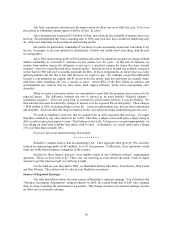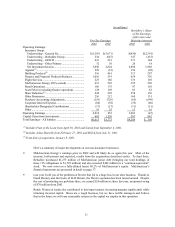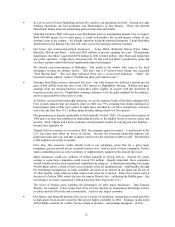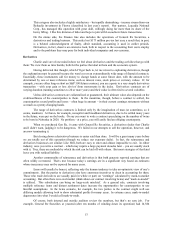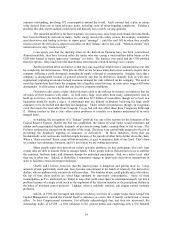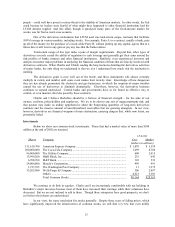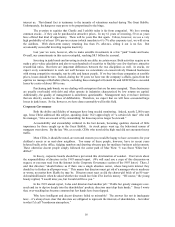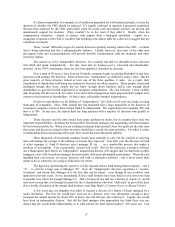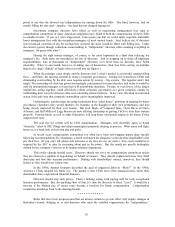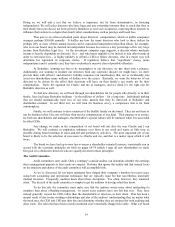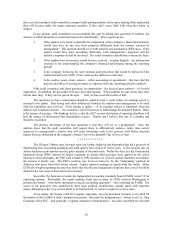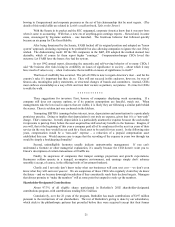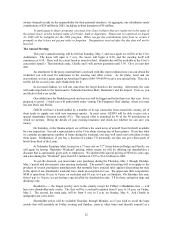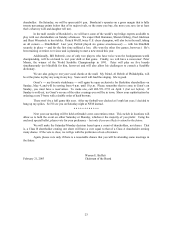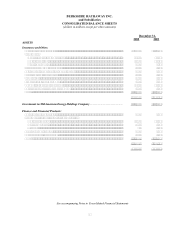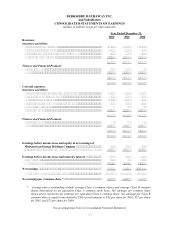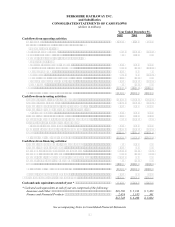Berkshire Hathaway 2002 Annual Report Download - page 21
Download and view the complete annual report
Please find page 21 of the 2002 Berkshire Hathaway annual report below. You can navigate through the pages in the report by either clicking on the pages listed below, or by using the keyword search tool below to find specific information within the annual report.20
this cozy relationship is audit committees unequivocally putting auditors on the spot, making them understand
they will become liable for major monetary penalties if they don’ t come forth with what they know or
suspect.
In my opinion, audit committees can accomplish this goal by asking four questions of auditors, the
answers to which should be recorded and reported to shareholders. These questions are:
1. If the auditor were solely responsible for preparation of the company’ s financial statements,
would they have in any way been prepared differently from the manner selected by
management? This question should cover both material and nonmaterial differences. If the
auditor would have done something differently, both management’ s argument and the
auditor’ s response should be disclosed. The audit committee should then evaluate the facts.
2. If the auditor were an investor, would he have received – in plain English – the information
essential to his understanding the company’ s financial performance during the reporting
period?
3. Is the company following the same internal audit procedure that would be followed if the
auditor himself were CEO? If not, what are the differences and why?
4. Is the auditor aware of any actions – either accounting or operational – that have had the
purpose and effect of moving revenues or expenses from one reporting period to another?
If the audit committee asks these questions, its composition – the focus of most reforms – is of minor
importance. In addition, the procedure will save time and expense. When auditors are put on the spot, they
will do their duty. If they are not put on the spot . . . well, we have seen the results of that.
The questions we have enumerated should be asked at least a week before an earnings report is
released to the public. That timing will allow differences between the auditors and management to be aired
with the committee and resolved. If the timing is tighter – if an earnings release is imminent when the
auditors and committee interact – the committee will feel pressure to rubberstamp the prepared figures. Haste
is the enemy of accuracy. My thinking, in fact, is that the SEC’ s recent shortening of reporting deadlines will
hurt the quality of information that shareholders receive. Charlie and I believe that rule is a mistake and
should be rescinded.
The primary advantage of our four questions is that they will act as a prophylactic. Once the
auditors know that the audit committee will require them to affirmatively endorse, rather than merely
acquiesce to, management’ s actions, they will resist misdoings early in the process, well before specious
figures become embedded in the company’ s books. Fear of the plaintiff’ s bar will see to that.
* * * * * * * * * * * *
The Chicago Tribune ran a four-part series on Arthur Andersen last September that did a great job of
illuminating how accounting standards and audit quality have eroded in recent years. A few decades ago, an
Arthur Andersen audit opinion was the gold standard of the profession. Within the firm, an elite Professional
Standards Group (PSG) insisted on honest reporting, no matter what pressures were applied by the client.
Sticking to these principles, the PSG took a stand in 1992 that the cost of stock options should be recorded as
the expense it clearly was. The PSG’ s position was reversed, however, by the “rainmaking” partners of
Andersen who knew what their clients wanted – higher reported earnings no matter what the reality. Many
CEOs also fought expensing because they knew that the obscene megagrants of options they craved would be
slashed if the true costs of these had to be recorded.
Soon after the Andersen reversal, the independent accounting standards board (FASB) voted 7-0 for
expensing options. Predictably, the major auditing firms and an army of CEOs stormed Washington to
pressure the Senate – what better institution to decide accounting questions? – into castrating the FASB. The
voices of the protesters were amplified by their large political contributions, usually made with corporate
money belonging to the very owners about to be bamboozled. It was not a sight for a civics class.
To its shame, the Senate voted 88-9 against expensing. Several prominent Senators even called for
the demise of the FASB if it didn’ t abandon its position. (So much for independence.) Arthur Levitt, Jr., then
Chairman of the SEC – and generally a vigilant champion of shareholders – has since described his reluctant


